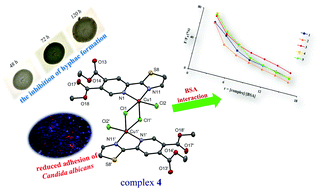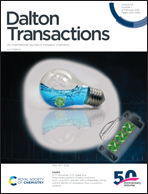Tailoring copper(ii) complexes with pyridine-4,5-dicarboxylate esters for anti-Candida activity†
Abstract
Five novel copper(II) complexes with pyridine-4,5-dicarboxylate esters as ligands, [Cu(NO3)(py-2tz)(H2O)3]NO3 (1), [Cu(NO3)2(py-2metz)(H2O)] (2), [Cu(NO3)2(py-2py)(H2O)]·H2O (3), [CuCl2(py-2tz)]2 (4) and [CuCl2(py-2metz)]n (5) (py-2tz is dimethyl 2-(thiazol-2-yl)pyridine-4,5-dicarboxylate, py-2metz is dimethyl 2-(4-methylthiazol-2-yl)pyridine-4,5-dicarboxylate and py-2py is dimethyl 2,2′-bipyridine-4,5-dicarboxylate), were synthesized and structurally characterized by different spectroscopic and electrochemical methods. The structure of these complexes was determined by single-crystal X-ray diffraction analysis, confirming the bidentate coordination mode of the corresponding pyridine-4,5-dicarboxylate ester to the Cu(II) ion through the nitrogen atoms. The antimicrobial potential of copper(II) complexes 1–5 was assessed against two bacterial and two Candida species. These complexes showed better growth inhibiting activity against Candida spp. with respect to the tested bacterial species, also being moderately toxic towards normal human lung fibroblast cells (MRC-5). Complexes 1 and 4 showed the greatest ability to inhibit the filamentation of C. albicans, which is an important process during fungal infection, and these two complexes efficiently inhibited the biofilm formation of C. albicans at subinhibitory concentrations. Complex 4 also successfully prevented the adhesion of C. albicans in an in vitro epithelial cell model. The mechanism of the antifungal activity of copper(II) complexes 1–5 was studied through their interaction with ct-DNA, as one of the possible target biomolecules, by fluorescence spectroscopy and gel electrophoresis. Finally, the ability of these complexes to bind to bovine serum albumin (BSA) was studied by fluorescence emission spectroscopy.



 Please wait while we load your content...
Please wait while we load your content...